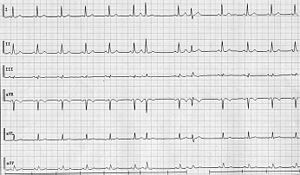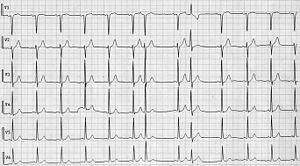Answer - 2008 03
| Author(s) | A.A.M. Wilde | |
| NHJ edition: | 2009:03,102 | |
| These Rhythm Puzzles have been published in the Netherlands Heart Journal and are reproduced here under the prevailing creative commons license with permission from the publisher, Bohn Stafleu Van Loghum. | ||
| The ECG can be enlarged twice by clicking on the image and it's first enlargement | ||
A 73-year-old man presents with palpitations (irregular heartbeat). There is no medical history. Physical examination reveals no abnormalities. A baseline ECG is presented in figures 1A and 1B, which together show a 12-lead ECG (extremity leads in figure 1A and precordial leads in figure 1B).
What is your diagnosis?
Answer
The ECG shows a regular supraventricular rhythm which based on P wave configuration is probably sinus rhythm. A premature narrow QRS complex follows the sixth sinus beat. In the T wave of that sinus beat a clear P wave is visible (lead V1) leading to the diagnosis premature atrial beat. This is followed by an incomplete compensatory pause. The next sinus beat is followed by a wider QRS complex with delayed conduction at the right side of the heart (i.e. ‘right bundle branch block’). This QRS complex is also preceded by a P wave, visible in the T wave (lead V1). The remainder of the strip shows regular sinus rhythm.
The wide QRS complex is a clear example of aberrant conduction. The refractory period of cardiac cells (in this case cells of the right bundle branch) is determined by intrinsic properties that are sensitive to, among other things, the preceding RR interval. The longer this interval, the longer the refractory period. Hence, a longer RR interval will be more likely to be followed by an aberrantly conducted supraventricular beat than short RR intervals. This phenomenon was first recognised during atrial fibrillation with inherent irregular RR intervals by Richard Ashman PhD, a physiologist at Louisiana State University School of Medicine in New Orleans. The depicted phenomenon is therefore referred to as Ashman’s phenomenon.[1] The other main determinator is obviously the coupling interval of the extrasystole itself (which also seems slightly shorter for the second compared with the first extrasystole).
Conclusion: sinus rhythm with supraventricular extrasystole with aberrant conduction (Ashman’s phenomenon).
References
-
Gouaux JL, Ashman R. Auricular fibrillation with aberration simulating ventricular paroxysmal tachycardia. Am Heart J 1947; 34: 366.

